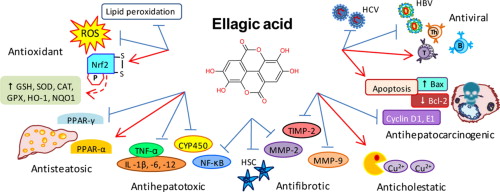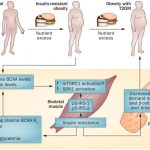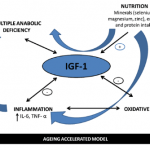Ellagic acid
Traditional drugs or therapies rarely have effects on regression of chronic liver diseases, which result in many cases from sustained oxidative stress. In recent years, ellagic acid (EA) has gained attention due to its multiple biological activities and several molecular targets. This is the first review focused on the pharmacological properties and on the molecular mechanisms activated by EA in terms of liver protection. EA possesses antioxidant, antihepatotoxic, antisteatosic, anticholestatic, antifibrogenic, antihepatocarcinogenic and antiviral properties that improves the hepatic architectural and functions against toxic and pathological conditions. The molecular mechanisms that EA activates include the scavenging of free radicals, regulation of phase I and II enzymes, modulation of proinflammatory and profibrotic cytokines synthesis, the regulation of biochemical pathways involved in the synthesis and degradation of lipids as well as the maintenance of essential trace elements levels. EA also inhibits hepatic stellate cells and mast cells activation, the proliferation of transformed cells, as well as viral replication by increasing antioxidant response, induction of apoptosis, downregulation of genes involved in cell cycle and angiogenesis, and stimulation of cellular immune response. Despite the enormous therapeutic potential of EA as an innovative pharmacological strategy, the number of phase I and II trials in patients is scarce, precluding its clinical application. In these sense, the use of new delivery systems that enhances EA bioavailability would improve the results already obtained. Also it remains to be determined if treatment with urolithins instead of EA would represent a better strategy in hepatic disease treatment.
NOTICE: Ellagic Acid is a natural nutrient found in many potent anti-cancer fruits and nuts. By itself, it is not a cancer treatment, but it is important to understand the importance of this nutrient when putting together your cancer treatment and especially your “cancer diet.”
Chapter on Natural Treatments For Advanced Cancer Patients
Contents
How It Works
Ellagic acid is a naturally occurring polyphenolic constituent found in 46 different fruits and nuts such as grapes, pomegranate, red raspberry, strawberry, blueberry, and walnuts. “[Ellagic acid] prevents the binding of carcinogens to DNA and strengthens connective tissue, which may keep cancer cells from spreading.” (1) Ellagic Acid has the ability to inhibit mutations within a cell’s DNA. Furthermore, it is considered to be a cancer inhibitor which has the ability to cause apoptosis or normal cell death in cancer cells.
Ellagic Acid
First, ellagic acid kills cancer cells:
Healthy cells have a normal life cycle of approximately 120 days before they die. This process is called apoptosis (natural cell death). The body replaces these dying cells with healthy cells. Conversely, cancer cells do not die. They multiply by division, making two cancer cells, then four, eight, 16, 32 and so on. In lab tests, Ellagic Acid caused the cancer cells to go through the normal apoptosis process without damaging healthy cells. Chemotherapy,radiation and most conventional treatments cause the death of cancer cells and healthy cells indiscriminately, possibly destroying the immune system in the process. Ellagic Acid is clearly the sensible choice. (2)
Second, ellagic acid stops the growth of tumors:
Rats that consumed 5-10 percent of their diet as freeze-dried black raspberries and strawberries showed dramatic reductions in the growth of precancerous cells and tumorprogression, the researchers found. And in other animal tests, Stoner told Reuters Health, the berries reduced colon cancer growth by 80 percent. The Ohio Department of Agriculture supported the research Stoner presented at the meeting. (2)
Third, ellagic acid causes G-arrest:
The Hollings Cancer Institute at the University of South Carolina has conducted a double blind study on a group of 500 cervical cancer patients that had everyone excited. Nine years of study have shown that a natural product called Ellagic acid is causing G-arrest within 48 hours (inhibiting and stopping mitosis-cancer cell division), and apoptosis (normal cell death) within 72 hours, for breast, pancreas, esophageal, skin, colon and prostate cancer cells. (3)
Fourth, ellagic acid helps prevent cancer, birth defects, etc.
European medical studies also demonstrate that Ellagic Acid is known to lower the incidence of birth defects, promote wound healing, reduce heart disease, and may reduce or reverse chemically induced liver fibrosis. (4)
Fifth, ellagic acid does a lot of other good things:
From Dr. Glen Halvorson’s Book, Chemopreventive Properties of …Phytochemicals, we learn that ellagic acid is antibacterial, [it] destroys the H. pylori bacteria responsible for stomach ulcers, [it] protects the liver and liver function, [it] binds with carcinogens (chemicals that cause cancer) making them inactive, [it] prevents carcinogens from binding to DNA [and it] reduces glucose levels (aids in management of diabetes). (5)
Sixth, ellagic acid (i.e. from ellagitannins), is combined with glucose,
making sure that cancer cells get a larger dose of ellagic acid than normal cells because cancer cells consume about 15 times more glucose than other cells. This means cancer cells probably get far more ellagic acid than normal cells:
Although ellagic acid is the bioactive agent that offers protection, the phytochemical is generally ingested in the form of another biochemical called ellagitannin. Plants produce ellagic acid and glucose that combine to form ellagitannins, which are water-soluble compounds that are easier for animals to absorb in their diets. Consequently, small amounts of ellagitannins derived from natural sources may be more effective in the human diet than large doses of purified ellagic acid. (6)
Here are some comments about blueberries
Extremely rich in a wide range of powerful antioxidant flavonoids (phenolic compounds). Blueberries/bilberries have more anthocyanins than any other food – three times more than the second richest source, green tea. They are also high in quercetin and ellagic acid – two other powerful flavonoids.
Flavonoids can also attach themselves to proteins, modulating the action of enzymes, including the kinase enzymes necessary for cell proliferation. In this way, they are a very useful complement to cancer therapy. When high doses of flavonoids are taken, all cell proliferation is inhibited; but this does not harm normal cells which can simply ‘rest’ – however, cancer cells cannot survive in the resting state.
Flavonoids also lower blood sugar levels, can restrict angiogenesis, help to keep nitric oxide within a healthy range and raise the body’s level of the endogenous antioxidant glutathione. Berries are also rich in vitamin C. (Original Page Down)
Here is how it works:
Ellagic Acid is a phenolic compound that has become known as a potent anti-carcinogenic/anti-mutagenic compound. It also has antibacterial and antiviral properties. Ellagic Acid itself is not thought to be naturally present in plants. Instead, polymers of gallic acid and hexahydroxydipenoyl (HHDP) are linked to glucose centers to form the class of compounds known as ellagitannins. When two gallic acid groups become linked side by side within a tannin molecule an HHDP group is formed. Ellagic Acid is the result when the HHDP group is cleaved from the tannin molecule and spontaneously rearranges. It is the ellagitannins that are present in red raspberries. (7)
Supercharging This Treatment
At the current time, ellagic acid supplements are generally not used as a stand-alone treatment for cancer. Rather, ellagic acid supplements are usually used in conjunction with other treatments. However, ellagic acid is found in fruits and nuts that are part of major alternative cancer treatments, such as the grape cure, Budwig Flaxseed (when walnuts are used), the Raw Food diet, etc.
It would probably be a mistake to take ellagic acid supplements without also consuming many natural, whole, raw foods that contain ellagic acid in order to get necessary enzymes and other synergistic nutrients.
The Hope For Cancer website, linked to below, uses an Ellagic Acid protocol and has had good results with lung cancer patients.
An alternative cancer treatment should be a complete treatment protocol. Do NOT forget to study the complete treatment protocol for Stage I, II and III cancer patients and the complete treatment protocol for Stage IV cancer patients:
Treatment For Stage I, II and III Cancer Patients
Treatment For Stage IV Cancer Patients
Site – Comments
- Ellagic Acid Vendor
- Hope For Cancer – Complete Ellagic Acid Protocol w/graviola
- Driscoll’s – Major articles on berries, Ellagic Acid, Quercetin, etc.
- Oregon Berries – Excellent article on Black Raspberries, Ellagic Acid, etc. (need Adobe Acrobat)
- Washington Red Rasp. Comm. – More than 125 scientific studies referenced.
- Vendor – Red Raspberry Extract






